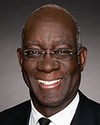That's wonderful.
Okay. My questions are yes or no questions, and if your answer is a “yes” and you could provide the committee the information that would validate your response, I would appreciate it. These are recommendations loosely over the course of the last seven and a half years.
In regard to non-medical and medical releases under this process, do you have specific points when you inform those who are enlisting, those who are serving and those who are eventually releasing or being medically released? Are there understood times in your process when that is done?



